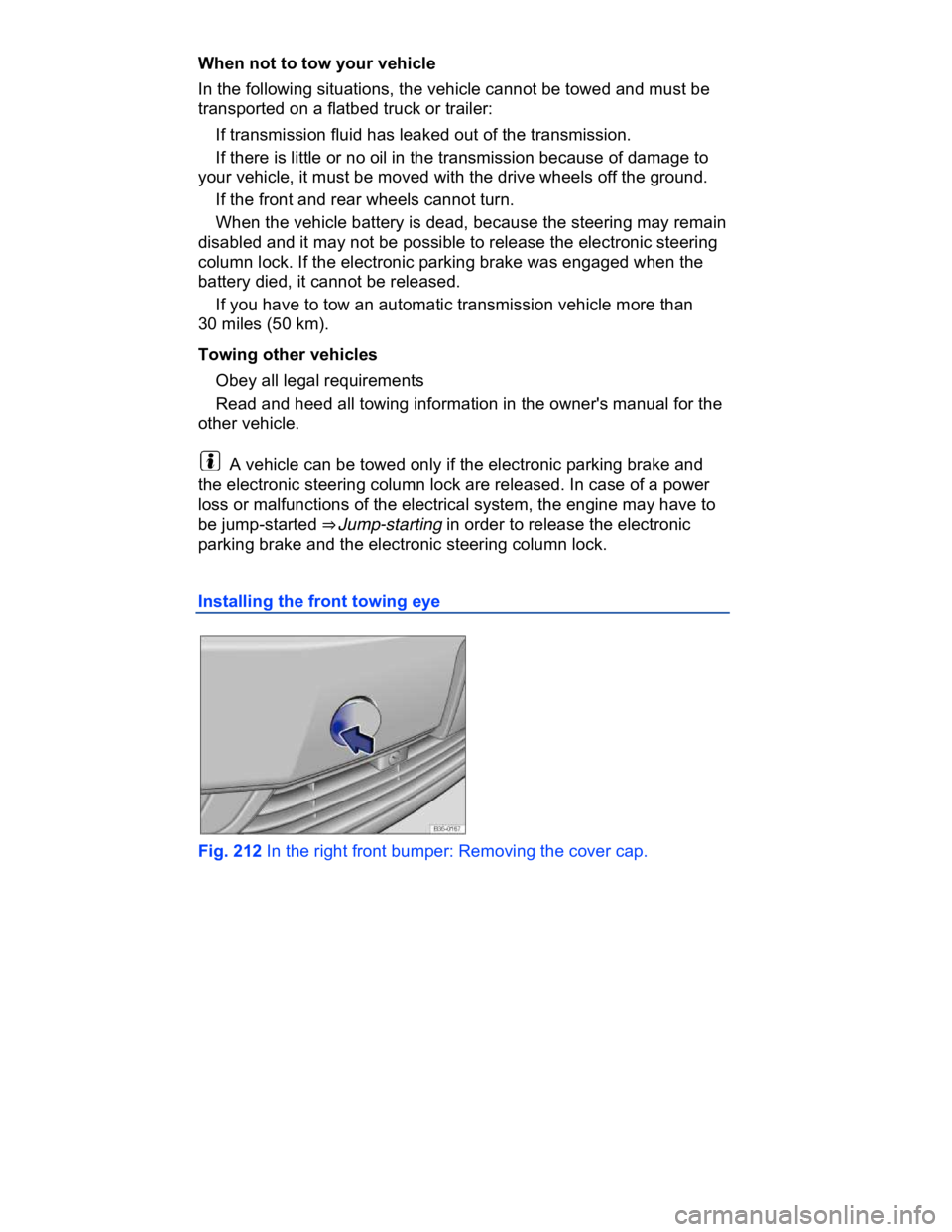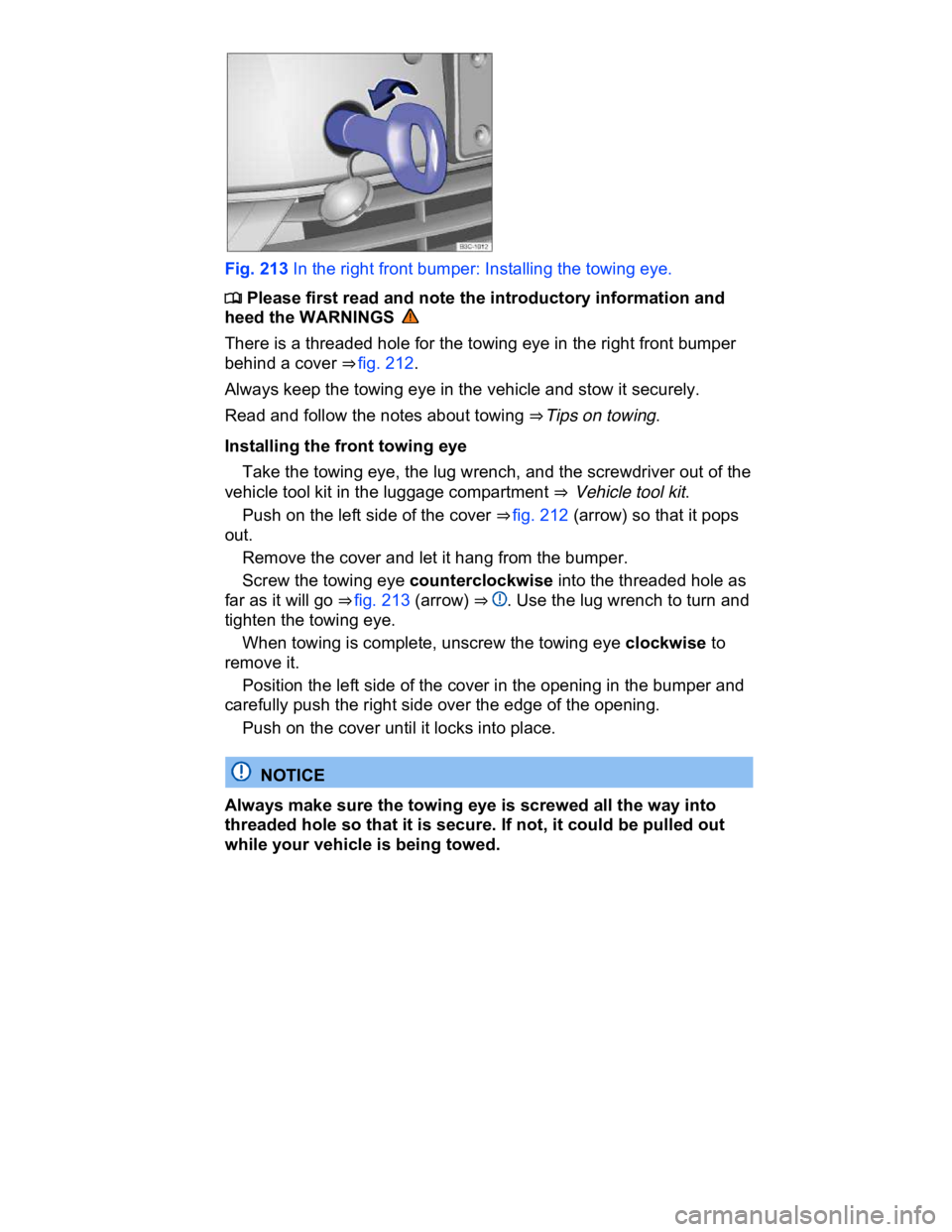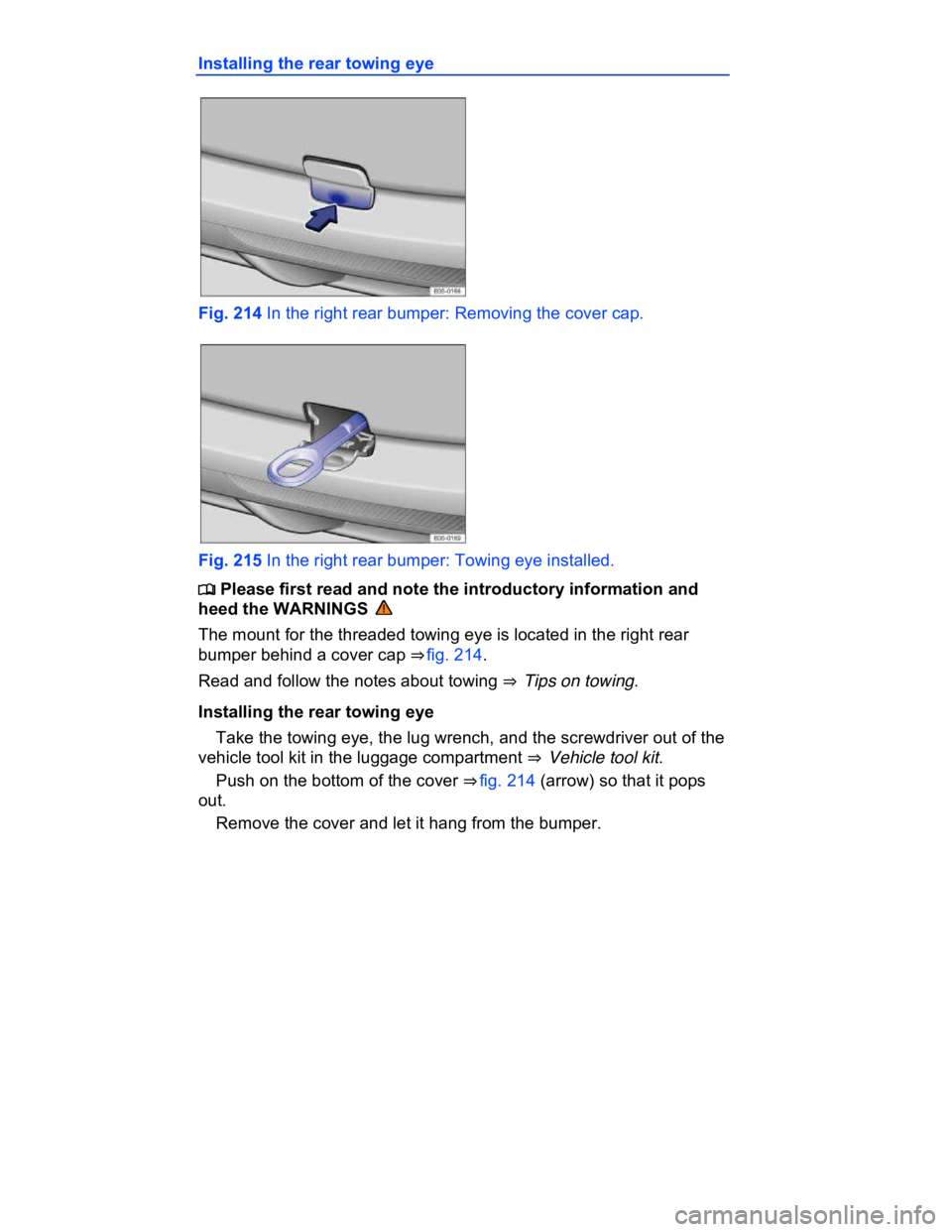VOLKSWAGEN CC 2011 Owners Manual
Manufacturer: VOLKSWAGEN, Model Year: 2011, Model line: CC, Model: VOLKSWAGEN CC 2011Pages: 578, PDF Size: 6.64 MB
Page 571 of 578

and easier on both vehicles than using a tow rope. A tow rope should
be used only if a tow bar is not available.
The tow rope should be flexible enough to help protect both vehicles
from damage. Use a synthetic fiber rope or similar rope.
Attach the tow rope or tow bar only to the towing eye included in the
vehicle tool kit for this purpose, or to a trailer hitch.
Towing manual transmission vehicles
Check whether your vehicle can be towed at all; see below ⇒ When
not to tow your vehicle
If yes, not the following for the towed vehicle:
� Shift the gearshift lever to Neutral ⇒ Shifting.
� Do not tow faster than 30 mph (50 km/h).
� Do not tow more than 30 miles (50 km).
Towing automatic transmission vehicles
Check whether your vehicle can be towed at all; see below ⇒ When
not to tow your vehicle
If yes, not the following for the towed vehicle:
� Put the transmission in Neutral (N).
� Do not tow faster than 30 mph (50 km/h).
� Do not tow more than 30 miles (50 km).
� When a commercial tow truck is being used, the vehicle must only
be towed with the front wheels lifted off the ground.
� Follow the special instructions for towing vehicles with all-wheel
drive (4MOTION).
Towing vehicles with all-wheel drive (4MOTION)
Vehicles with all-wheel drive (4MOTION) should be towed with a tow
bar or a tow rope. If the vehicle is towed with the front or rear axles
lifted off the ground, the engine must be switched off. Otherwise the
powertrain may be damaged.
For vehicles with the DSG® Direct Shift Gearbox, also follow the di-
rections on how to tow a vehicle with automatic transmission ⇒ Tow-
ing automatic transmission vehicles.
Page 572 of 578

When not to tow your vehicle
In the following situations, the vehicle cannot be towed and must be
transported on a flatbed truck or trailer:
� If transmission fluid has leaked out of the transmission.
� If there is little or no oil in the transmission because of damage to
your vehicle, it must be moved with the drive wheels off the ground.
� If the front and rear wheels cannot turn.
� When the vehicle battery is dead, because the steering may remain
disabled and it may not be possible to release the electronic steering
column lock. If the electronic parking brake was engaged when the
battery died, it cannot be released.
� If you have to tow an automatic transmission vehicle more than
30 miles (50 km).
Towing other vehicles
� Obey all legal requirements
� Read and heed all towing information in the owner's manual for the
other vehicle.
A vehicle can be towed only if the electronic parking brake and
the electronic steering column lock are released. In case of a power
loss or malfunctions of the electrical system, the engine may have to
be jump-started ⇒ Jump-starting in order to release the electronic
parking brake and the electronic steering column lock.
Installing the front towing eye
Fig. 212 In the right front bumper: Removing the cover cap.
Page 573 of 578

Fig. 213 In the right front bumper: Installing the towing eye.
�
Page 574 of 578

Installing the rear towing eye
Fig. 214 In the right rear bumper: Removing the cover cap.
Fig. 215 In the right rear bumper: Towing eye installed.
�
Page 575 of 578

� Screw the towing eye counterclockwise into the threaded hole as
far as it will go ⇒ fig. 215 ⇒ . Use the lug wrench to turn and tighten
the towing eye.
� When towing is complete, unscrew the towing eye clockwise to
remove it.
� Position the bottom of the cover in the opening in the bumper and
carefully push the top of the cover over the edge of the opening.
� Push on the cover until it locks into place.
NOTICE
Always make sure the towing eye is screwed all the way into
threaded hole so that it is secure. If not, it could be pulled out
while your vehicle is being towed.
Driving tips while towing
�
Page 576 of 578

� Since power steering does not work when the engine is switched
off, more effort is needed to steer the vehicle.
� Since the brake booster also does not work when the engine is
stopped, you will need to press harder on the brake pedal to slow
down or stop. Do not hit the towing vehicle.
� Read and heed the information and WARNINGS in the towing ve-
hicle's owner's manual.
As the driver of the towing vehicle:
� Drive especially carefully and accelerate gently. Avoid sudden driv-
ing maneuvers.
� Brake earlier and more gently than usual and with light pedal pres-
sure.
� Read and heed the information and WARNINGS in the owner's
manual of the vehicle being towed.
Page 577 of 578

Abbreviations
Abbreviation Meaning
ABS Anti-lock Brake System
AFS Adaptive Front Lighting System
AKI Anti-Knock Index
ANSI American National Standards Institute
ASR Anti-Slip Regulation
ATA Anti-Theft Alarm system
BAS Brake Assist System
ccm Cubic centimeter – metric unit of measure for engine
displacement
CCS Cruise Control System
CID Cubic inch displacement – unit of measure for engine
displacement
cm Centimeter – metric unit of measure for length
CO2 Carbon dioxide
DIN Deutsches Institut für Normung (German Institute for
Standardization)
DRL Daytime Running Lights
DSG® Direct Shift Gearbox automatic transmission
EDL Electronic Differential Lock
EN European Norm
EPC Engine control (Electronic Power Control)
ESC Electronic Stability Control
g/km Generated carbon monoxide amount in grams per
kilometer driven
GAWR Gross Axle Weight Rating
GVWR Gross Vehicle Weight Rating
HID High Intensity Discharge headlights (Xenon)
Page 578 of 578

hp Horsepower – unit of measure for engine power
kg Kilogram – metric unit of measure for weight
kN Kilonewton – a unit of measure for force
kPa Kilopascal – unit of measure for tire pressure
kp Kilopond – unit of measure for force
kW Kilowatt – engine rating
LED Light Emitting Diode
m Meter – metric unit of measure for length
MDI Media Device Interface (MEDIA-IN)
MFI Multi-Function Indicator
Nm Newton meter – a unit of measure for engine torque
PDC Park Distance Control
RON Research Octane Number – measurement of anti-
knock resistance of gasoline
rpm Engine revolutions per minute (engine speed)
SAE Society of Automotive Engineers
TSI® Turbocharged gasoline engine with direct fuel injec-
tion
XDL Extension of the Electronic Differential Lock system
5S man 5-speed manual transmission
6S auto 6-speed automatic transmission
6S man 6-speed manual transmission